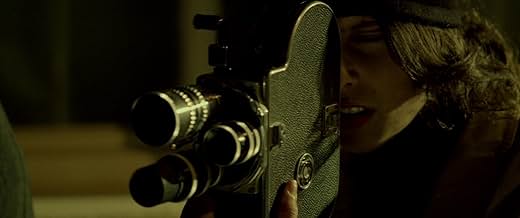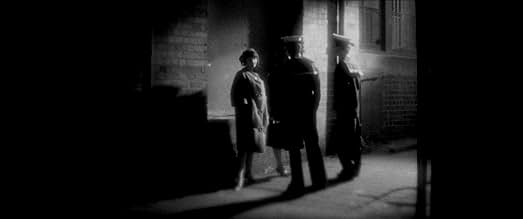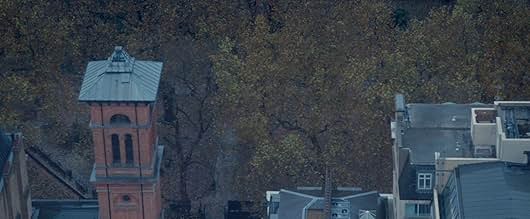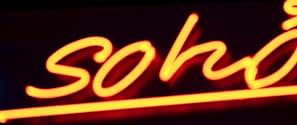Aggiungi una trama nella tua linguaLondon's Soho district, the Fifties. Through the eyes of a Bolex camera, a typewriter and some local lifers a group of friends set out to produce a revolution. Will they succeed? You bet.London's Soho district, the Fifties. Through the eyes of a Bolex camera, a typewriter and some local lifers a group of friends set out to produce a revolution. Will they succeed? You bet.London's Soho district, the Fifties. Through the eyes of a Bolex camera, a typewriter and some local lifers a group of friends set out to produce a revolution. Will they succeed? You bet.
- Regia
- Sceneggiatura
- Star
- Premi
- 3 vittorie e 3 candidature totali
Recensioni in evidenza
An adaptation of Colin Wilson's 1961 novel, following the lives of a group of intriguing characters, some real, some not, as they strive to discover the true nature of freedom. This atmospheric movie, set in London's Soho in 1959, is also a homage to the 1950s Free Cinema movement in which then up-and-coming moviemakers like Lindsay Anderson, Karel Reisz, Tony Richardson, Claude Goretta and others took their Bolex cameras out onto the streets, and into the cellars, of post-war London filming what they saw. Depicting some of the major events of the time, like the first CND march to Aldermaston, this mesmerizing mosaic of a film rewards multiple viewings. Highly recommended.
Review by Rodney Wilson.
I have to say, this film came as a pleasant surprise. I didn't know the director and my expectations were low! The film is based on my brother Colin's novel and he hasn't been too successful in adaptations of his work -he would have envied Grahame Green if he hadn't hated his work so much!- Colin's Space Vampires or Lifeforce were lamentable.
Now the 1960s Adrift in Soho is possibly my favorite book of Colin, so my prime concern was to see whether the film had done justice to the book.
Half-an-hour into the film, I decided to forget Colin's book. And when the character James was killed off, I had completely forgotten the book! I was convinced by then the film had an independent life to the book on which it was based. I was so enthralled by the photography -the out-of-focus '50s footage opening sequence is inspired- that I made up my mind to enjoy the film in its own right, and that came easily.
The camera shot of a first-edition of The Outsider in a Soho bookshop is all I needed to appreciate the connection to Colin. I consider myself a "film buff" but shamefully I confess to no knowledge of the Free Cinema film movement that had inspired the director. But it didn't matter.
The film evokes 1950s Soho as atmospherically as anyone could have wished, and the eccentric Soho types didn't disappoint. Colin's book explores the nature of freedom, and to that extent the film was true to the book, as well as following the storyline to a recognizable extent. I felt the film was a valiant effort to capture an era that is now gone, and gone for good. That is no mean achievement. I thank the director for the experience, and shall follow his career with an interest I certainly didn't have before I saw the film. Well done. Rodney Wilson.
I have to say, this film came as a pleasant surprise. I didn't know the director and my expectations were low! The film is based on my brother Colin's novel and he hasn't been too successful in adaptations of his work -he would have envied Grahame Green if he hadn't hated his work so much!- Colin's Space Vampires or Lifeforce were lamentable.
Now the 1960s Adrift in Soho is possibly my favorite book of Colin, so my prime concern was to see whether the film had done justice to the book.
Half-an-hour into the film, I decided to forget Colin's book. And when the character James was killed off, I had completely forgotten the book! I was convinced by then the film had an independent life to the book on which it was based. I was so enthralled by the photography -the out-of-focus '50s footage opening sequence is inspired- that I made up my mind to enjoy the film in its own right, and that came easily.
The camera shot of a first-edition of The Outsider in a Soho bookshop is all I needed to appreciate the connection to Colin. I consider myself a "film buff" but shamefully I confess to no knowledge of the Free Cinema film movement that had inspired the director. But it didn't matter.
The film evokes 1950s Soho as atmospherically as anyone could have wished, and the eccentric Soho types didn't disappoint. Colin's book explores the nature of freedom, and to that extent the film was true to the book, as well as following the storyline to a recognizable extent. I felt the film was a valiant effort to capture an era that is now gone, and gone for good. That is no mean achievement. I thank the director for the experience, and shall follow his career with an interest I certainly didn't have before I saw the film. Well done. Rodney Wilson.
I have to agree with Sebastian Noyes this is an awful adaption of the book. After hearing about the film I tried to see it. It took me over a year to track it down. It seems it was extremely hard to sell to a distributor and Behrens was extremely overprotective on who released it. ... I now know why.
The direction by Behrens is inept and lacks any form of atmosphere that you find in the book. The book has real characters. This does not. The direction of the actors was awful and most performances are not only wooden but not in the least entertaining. Trying to follow the character's story was like walking through treacle.
The cinematography was extremely poor for a film with a 2 million dollar budget. This is what you get for 2 million can you believe it? I felt sorry for some of the actors because I have seen some of them in other films and they are actually good actors and they acted well and convincingly in their characters in the other films but not in this film with this director.
In this film, it is hard to feel any empathy for any character. It drifts along in ineptitude. "Adrift" in Soho ... ironic.
Those who gave it 9/10 or such scores must be in it or work for Behrens. I cannot think of any other reason. It is interesting that some of the phrases used in the reviews are used in the press releases.
Use the 100 minutes of your life to do something else. AVOID.
The direction by Behrens is inept and lacks any form of atmosphere that you find in the book. The book has real characters. This does not. The direction of the actors was awful and most performances are not only wooden but not in the least entertaining. Trying to follow the character's story was like walking through treacle.
The cinematography was extremely poor for a film with a 2 million dollar budget. This is what you get for 2 million can you believe it? I felt sorry for some of the actors because I have seen some of them in other films and they are actually good actors and they acted well and convincingly in their characters in the other films but not in this film with this director.
In this film, it is hard to feel any empathy for any character. It drifts along in ineptitude. "Adrift" in Soho ... ironic.
Those who gave it 9/10 or such scores must be in it or work for Behrens. I cannot think of any other reason. It is interesting that some of the phrases used in the reviews are used in the press releases.
Use the 100 minutes of your life to do something else. AVOID.
Confession : This film lost me within the first two minutes due to my own personal dislike of highly stylised imagery in movies. Still, I wanted to like it and tried to give it a fair chance. It IS set in 50s Soho, after all - a place I know well, although long after its 50s & 60s heyday - and it purports to be something of a philosophical exploration of the intellectual and cultural scene there at the time. Surely there would be something there to win me over?
Nope. Firstly, the outdoor scenes look like... well... anywhere but Soho. Secondly, it fails almost completely to evoke the 1950s. There's no attempt to conjure up the atmosphere of time or place. Thirdly, erm... who are the characters again? Thirty minutes in and we barely know who they are or if we're supposed to like/hate/admire them, or even just find their dialogue interesting. It would be unfair to put that down to bad acting - it's more a result of bad writing and directing. The director knows what he's trying to create, but completely fails to communicate it to the audience.
Thirty five minutes in, and I'm reduced to fast-forwarding just to get the ordeal over with. I'm not familiar with the novel - it's probably vastly more interesting than this, and one day I might give it a try. If you've read it then you may get more out of the film than I was able to, but for anyone coming to it 'cold' then it's just uninteresting, self-indulgent, inept drivel.
Nope. Firstly, the outdoor scenes look like... well... anywhere but Soho. Secondly, it fails almost completely to evoke the 1950s. There's no attempt to conjure up the atmosphere of time or place. Thirdly, erm... who are the characters again? Thirty minutes in and we barely know who they are or if we're supposed to like/hate/admire them, or even just find their dialogue interesting. It would be unfair to put that down to bad acting - it's more a result of bad writing and directing. The director knows what he's trying to create, but completely fails to communicate it to the audience.
Thirty five minutes in, and I'm reduced to fast-forwarding just to get the ordeal over with. I'm not familiar with the novel - it's probably vastly more interesting than this, and one day I might give it a try. If you've read it then you may get more out of the film than I was able to, but for anyone coming to it 'cold' then it's just uninteresting, self-indulgent, inept drivel.
I wanted to like this film, but it didn't take long until it became clear it's simply awful.
First, there is little attempt to create any sense of 1950s periodicity. Some token gestures are made with costumes (apparently, nearly everyone in the 1950s always wore long overcoats) but these are confused, for in some cases, character stylings look more 60s (e.g., documentarian Jo's three-quarter length raincoat and black tights).
Second, for a film so defined by place, it fails of evoke the look of Soho. While I can understand it could be expensive to get the permits for shooting in central London, repeatedly using the Lace Market in Nottingham is not a passable substitute. Towards the end of the film, a couple of moments are particularly anomalous. When James and Harry appear on the banks of the Thames, you can see the skyscrapers of a very modern London behind them. Ok, it isn't necessary to achieve 100% veracity, and so placing The French House on the corner on Old Compton Street can be forgiven (its actually on the southern end of Dean Street). Still, given the establishment's history (meeting place for the French resistance in WW2 etc.), placing ITALIAN flags on the outside signage (green-white-red instead of blue-white-red) is just bizarre!
Third, as other commentators have noted, the acting is just dreadful. There are many performances to dislike here but Chris Wellington as James Compton-Street is probably the least convincing. In the actors' defence, they are burdened by an unactable script that tries to be poetry at times, and occasionally throws in snippets from Comte de Lautréamont. Weird that a film that appears to want to celebrate film should fall back on that old cliché of believing literature, particularly poetry, are higher forms of expression. They are not. Linking back to the first point here, casting choices are also incongruous, with most of the ensemble looking entirely like early 21st century twenty somethings. It wouldn't have taken much, but a few haircuts might have helped create some period plausibility.
Finally, allusions to cinéma verité, Free Cinema, and Dziga Vertov (i.e., eye poster on a wall) appear gratuitous given the film's fumbling artifice.
Having worked in animated film production in Soho during the 80s, I know the place well, but you really don't need any real-world reference to know this is a bad movie.
First, there is little attempt to create any sense of 1950s periodicity. Some token gestures are made with costumes (apparently, nearly everyone in the 1950s always wore long overcoats) but these are confused, for in some cases, character stylings look more 60s (e.g., documentarian Jo's three-quarter length raincoat and black tights).
Second, for a film so defined by place, it fails of evoke the look of Soho. While I can understand it could be expensive to get the permits for shooting in central London, repeatedly using the Lace Market in Nottingham is not a passable substitute. Towards the end of the film, a couple of moments are particularly anomalous. When James and Harry appear on the banks of the Thames, you can see the skyscrapers of a very modern London behind them. Ok, it isn't necessary to achieve 100% veracity, and so placing The French House on the corner on Old Compton Street can be forgiven (its actually on the southern end of Dean Street). Still, given the establishment's history (meeting place for the French resistance in WW2 etc.), placing ITALIAN flags on the outside signage (green-white-red instead of blue-white-red) is just bizarre!
Third, as other commentators have noted, the acting is just dreadful. There are many performances to dislike here but Chris Wellington as James Compton-Street is probably the least convincing. In the actors' defence, they are burdened by an unactable script that tries to be poetry at times, and occasionally throws in snippets from Comte de Lautréamont. Weird that a film that appears to want to celebrate film should fall back on that old cliché of believing literature, particularly poetry, are higher forms of expression. They are not. Linking back to the first point here, casting choices are also incongruous, with most of the ensemble looking entirely like early 21st century twenty somethings. It wouldn't have taken much, but a few haircuts might have helped create some period plausibility.
Finally, allusions to cinéma verité, Free Cinema, and Dziga Vertov (i.e., eye poster on a wall) appear gratuitous given the film's fumbling artifice.
Having worked in animated film production in Soho during the 80s, I know the place well, but you really don't need any real-world reference to know this is a bad movie.
Lo sapevi?
- QuizThe producers of the film met by chance at The Gutter Bar on La Croisette when the Cannes Film Festival of 2014 was just beginning. It was eleven o'clock at night and they were the only ones left.
I più visti
Accedi per valutare e creare un elenco di titoli salvati per ottenere consigli personalizzati
Dettagli
Botteghino
- Budget
- 2.000.000 USD (previsto)
- Tempo di esecuzione
- 1h 48min(108 min)
- Colore
- Mix di suoni
- Proporzioni
- 2.35 : 1
- 4:3
Contribuisci a questa pagina
Suggerisci una modifica o aggiungi i contenuti mancanti











